
We hope you love the products we recommend! All of them were independently selected by our editors. Just so you know, BuzzFeed may collect a share of sales or other compensation from the links on this page if you decide to shop from them. Oh, and FYI — prices are accurate and items in stock as of time of publication.
With ever-increasing wildfires that are larger and more destructive than in the past and rising concern over health risks associated with indoor air pollution from sources like gas stoves, air quality seems to be on people’s minds more than ever before. One potential solution for getting rid of contaminants in your home is an air purifier.
Before you start researching the best air purifier to buy, it’s important to understand what they can actually do and what you should be looking for depending on your particular space and risk factors.
Do air purifiers work?
The short answer is yes, but that doesn’t mean they’re capable of clearing any and all pollutants or germs out of the air indoors. (Although air cleaners do help block the COVID-causing virus, research suggests.)
A 2018 technical summary by the Environmental Protection Agency evaluated various studies to conclude that air cleaners operating in homes consistently reduce exposure to indoor particulate matter that is 2.5 to 10 microns in size. For reference, the smallest particles visible to the human eye are generally in the 50- to 60-micron range; a human hair is around 75 microns, pollen is 5 to 11 microns, dust is 0.5 to 3 microns, and tobacco smoke is around 1 micron or smaller.
Very small particulate matter can adversely affect the cardiovascular system because when you inhale them, they can travel deeper into the lungs than larger particles.
Essentially, air purifiers can reduce particles floating around indoors, though the actual health benefits of that reduction may not be as substantial as you’d hope. The EPA summary states that most studies have found a link between portable air cleaners in homes and at least one marker of improved health, although the improvements are typically modest.
How well an air purifier works also depends on proper use, meaning that it’s appropriate for the size of the space, placed correctly (not in some corner behind a curtain), has a certified filter that’s cleaned or changed as needed, and is run continuously with doors and windows closed.
“The amount of time that an air cleaner operates influences its ability to reduce pollutant concentrations and associated health risks,” according to an EPA report. “If they are not operating, they will not be effective.” While adequate ventilation is also helpful in maintaining cleaner indoor air, the free flow of air will make it more difficult for an air purifier to achieve the desired results.
In order to measure the actual efficacy of air purifiers, the Association of Home Appliance Manufacturers (a private voluntary standard-setting trade association) developed the clean air delivery rate, or CADR, which is a measure of how much clean air a portable air purifier delivers measured in cubic feet per minute (cfm).
The EPA says the CADR is the most helpful parameter for understanding the effectiveness of portable air cleaners.
“The testing program is very simple,” said Jill Notini, vice president of marketing and communications for the Association of Home Appliance Manufacturers (AHAM). “It looks at tobacco smoke, dust, and pollen, and the reason why is because those are three different particle sizes, so they're good representatives for a small particle, a medium particle, and a larger particle.”
The higher the CADR number for each pollutant, the faster the unit filters the air. As a general rule, AHAM advises that each CADR number of your air cleaner should be equal to at least two-thirds of the room’s area. For example, the AHAM website says that a room with the dimensions of 10 feet by 12 feet, or an area of 120 square feet, should have an air cleaner with a smoke CADR of at least 80.
Aside from evaluating particle capture, their testing also looks at the fans and motors in these machines to see how much air they’re able to pull in and keep moving through the filters. The CADR includes both the removal efficiency for a particular pollutant and the device’s airflow rate.
Notini said that pollen is one of the largest particles and smoke is one of the smallest, measuring in at 2.5 microns, aka a very fine particle that you can’t see but can easily inhale. She also said that AHAM will be releasing a new standard for the removal of germs like fungi, bacteria, and viruses (which people are looking for increasingly in the age of COVID). It’s also working on a chemical standard to include in its evaluations in the next few months.
In a 2020 study published in the International Journal of Environmental Research and Public Health, researchers set up real and sham air purifiers in the homes of 32 healthy people and compared the air quality and volunteers’ lung function during different four-week periods. They found having an air purifier reduced the indoor 2.5 microns particulate matter level by about 11%, but the result was only statistically significant in the homes of single people (possibly due to fewer doors opening and closing and less activity in general). The air purifiers didn’t seem to improve lung function or reduce airway inflammation.
It’s possible air purifiers could be more helpful in homes of people with pets, smokers, higher-risk individuals, or those with a different model of air purifier, since effectiveness does vary from product to product. This study may also have been too brief to detect an impact on health. The CDC looked at data from multiple studies and concluded that portable air cleaners, particularly those with HEPA filters, are effective in reducing exposure to air pollutants produced by wildfires and can potentially limit the negative health impacts from that exposure.
Dr. David Rosenstreich, the director of Allergy and Immunology at Montefiore Medical Center, explained that since dust is one of the larger particles, it tends to settle on surfaces, which makes it harder for an air purifier to suck in and capture.
He recommends air purifiers more often for people with pets or who have a mold issue, since animal dander and mold spores are the most common allergens that float through the air.
Air purifiers require some upkeep so that they continue to function as intended. Studies have shown that after an initial period of use and enthusiasm, the devices are often not maintained properly, operated less frequently, turned off completely, or put into storage because people are annoyed with the noise or other factors, according to the EPA.
That’s one good reason you should consider every possible feature when choosing an air purifier and try to find one that meets your needs. If it ends up in a closet after a month, it will be a waste of money.
How to choose the best air purifier
The priority in selecting an air purifier should, of course, be its effectiveness in cleaning air. But there are many different kinds of air purifiers with similar CADRs, so think about the other features that will encourage continued use.
One popular feature is a HEPA (high-efficiency particulate air) filter, which has deep pleats and a large surface area to help remove fine and ultrafine particles more efficiently. Air purifiers that have HEPA filters are probably the most popular and effective products on the market. (Rosenstreich recommends them exclusively.) However, they also have to be changed after 12 months or 8,760 hours of use.
If you tend to forget about things like changing filters, the alternative may be an air purifier with an electrostatic precipitator, which has a metal plate that charges particles so they become attracted to a plate with the opposite charge. Since the particles stick to the plate, you can simply remove it, clean it, and pop it back in instead of buying replacement filters, Notini said. Some of these types of air purifiers can produce low levels of ozone, which is a lung irritant, so they may not work for everyone.
Other air cleaners use combined technologies to increase their filtration. They may have activated carbon or charcoal filters to help remove gases and odors.
They can also have germ-killing features, like a UV light, to help reduce any bacteria or viruses that may get caught in the filters. It’s also common for air purifiers to use a pre-filter, which is generally a thicker flat or paneled filter that’s helpful in capturing larger particles, along with the main filter. These filters need to be replaced more frequently, but some varieties are washable for repeated use.
After deciding on a filtration system, experts agree that the most important consideration is the size. If it’s more powerful than necessary for a small room, the sound may be too loud and intense; if it’s too small, it won’t work properly.
Products should be labeled with a CADR based on the size of the room they’re suitable for, so you should know the measurements of your space before shopping around. It’s also important to note that the label will indicate the highest possible CADR, which typically occurs only at the highest (and likely loudest) airflow setting. It will have a separate score for each pollutant measured (dust, pollen, and tobacco smoke), which allows you to make sure it does the best job of eliminating the particle you’re concerned about.
You can look out for the AHAM seal of approval, though there are other CADR evaluators, so just read the fine print to make sure it’s legit.
Once you’ve determined your room size and CADR requirements, you should think about noise level and aesthetics. Since it should be placed in a high traffic area to address the densest levels of contamination and odor, it probably shouldn’t be overwhelmingly noisy or unpleasant to look at. Notini said that companies have done a lot of work on sound and design to make air purifiers that are not only functional, but also quieter and aesthetically pleasing.
Note what the labels or reviewers say about sound. Some products even have videos online so that you can hear exactly how loud they are at various settings. The designs are more of a personal preference, but there is a very wide range of shapes, colors, and general vibes on the market. These are some of the best options we’ve found, all things considered.
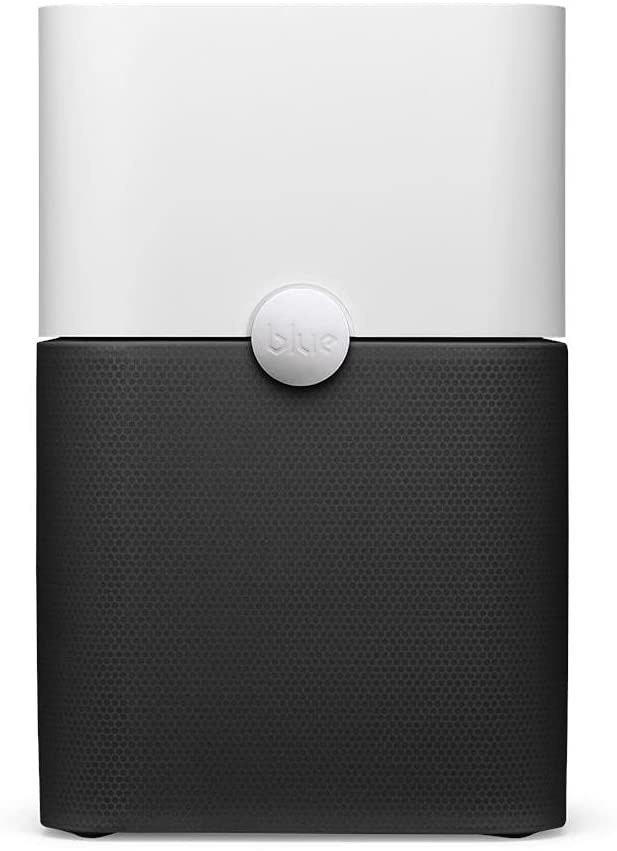
Blueair makes some of the best-looking, quietest air purifiers that are also highly rated in effectiveness. They’re not the cheapest, but they’re also not the most expensive, and you’re paying for quality along with superior aesthetics. This model is verified by AHAM to filter medium to large rooms (up to 540 square feet) five times an hour, with another option suitable for rooms up to 620 square feet. It includes two washable fabric pre-filters and a collapsible carbon filter (all of which come with the purifier), which use electrostatic filtration to remove up to 99.97% of airborne particles. The activated carbon layer is intended to trap light household odors from pets, cooking, or smoke. It’s also Energy Star certified for energy efficiency; the company says the sound on the lowest setting is akin to a whisper and on the highest is like rainfall.
Promising review: “We purchased these units for a rental property that had smokers living there for several years. The new tenants report that as long as they keep them running, they do not smell cigarette smoke. We find them to be economical and cost-effective to use every day. Also, they have held up well for several years now.” —Ken Oister
What else to consider: This air purifier is definitely substantial in size, with a base of 12 inches by 12 inches and a height of just over 20 inches. It looks good but it does take up a decent amount of space. It’s also easy to control with a single button, and the built-in warning system lets you know when it’s time to replace the filter.
Best for: medium to large rooms with space for a decent-sized air purifier that looks sleek, runs quietly, and still removes the majority of airborne particles with a combination of electrostatic and mechanical filtration.
You can buy the Blueair Blue Pure 211+ Air Purifier from Amazon for around $298.
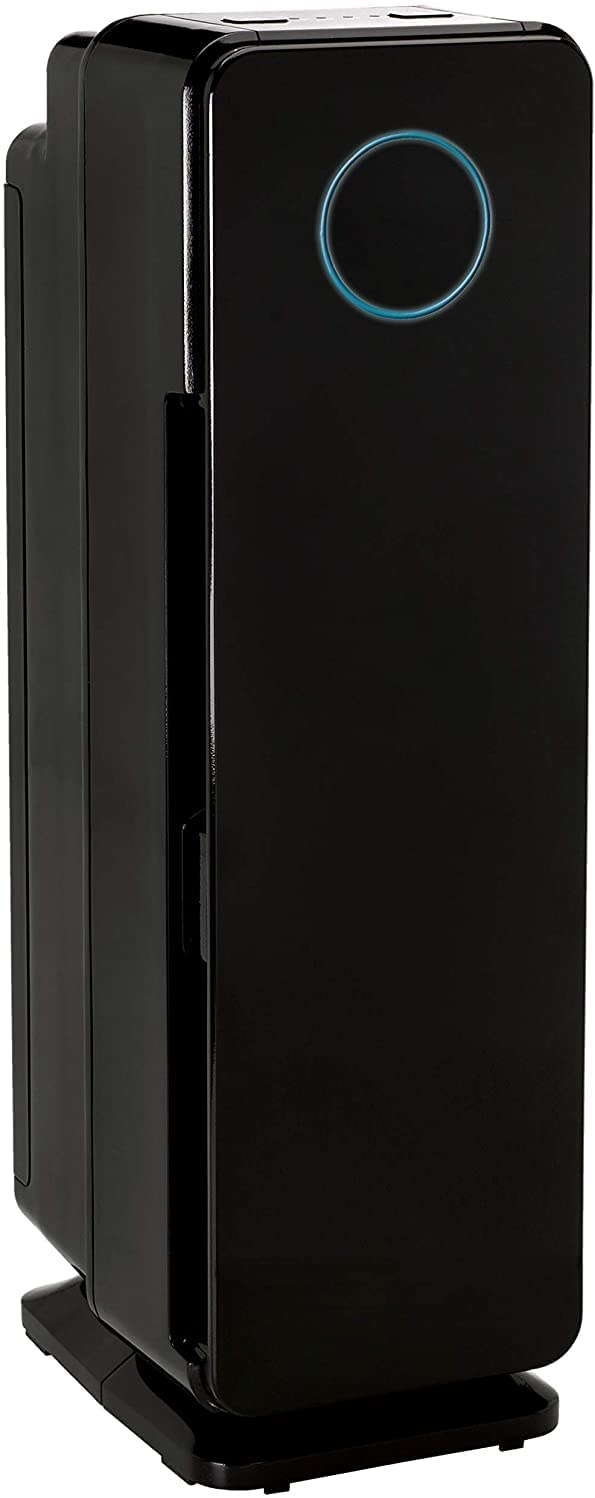
GermGuardian may not have the brand recognition of a Dyson or Honeywell air purifier, but it actually makes some of the best products you can get at a more affordable price point. This model is a sleek tower that comes in black or white, in single units or packs of two. The electrostatic HEPA filters reduce up to 99.97% of particles as small as 0.3 microns from the air, with an added UV light to help kill airborne viruses. There’s also a pre-filter to trap larger particles and an added antimicrobial agent to inhibit the growth of mold or odor-causing bacteria within the machine. It’s Energy Star and AHAM certified with CADR ratings of 99 for smoke, 107 for dust, and 116 for pollen. It can be effective in rooms of varying size depending on how many times per hour you want the air filtered (only one exchange per hour in rooms of 743 square feet but nearly five exchanges per hour in 153-square-foot rooms).
Promising review: “We have two cats and an infant, have noticed a major difference in smell when we use this. Smells disappear within a day, particularly in the nursery. Air is very easy to tell the difference (comparing stepping outside vs in the room we use this in). High setting is quiet enough not to be a bother overnight, placement of fans on the sides vs front is aesthetically appealing. Ordering smaller size for bathrooms. Very satisfied!” —Connor Revell
What else to consider: The original model of this air purifier was effective, but many reviewers had issues with a smoky smell coming from the control board. This newer model seems to be adjusted to hopefully avoid that problem. This product is a bit slimmer and taller than the Blueair with a roughly 9-inch base and 22-inch height. GermGuardian recommends changing the regular filter every six to eight months, but it may benefit you to change it more frequently if you have pets or to replace the carbon filter at closer to three months for better odor elimination. The review section also includes videos to help you gauge the sound levels.
Best for: smaller to medium-sized rooms where you want to maximize air purification and odor reduction.
You can buy the GermGuardian True HEPA Filter Air Purifier from Amazon for around $130.
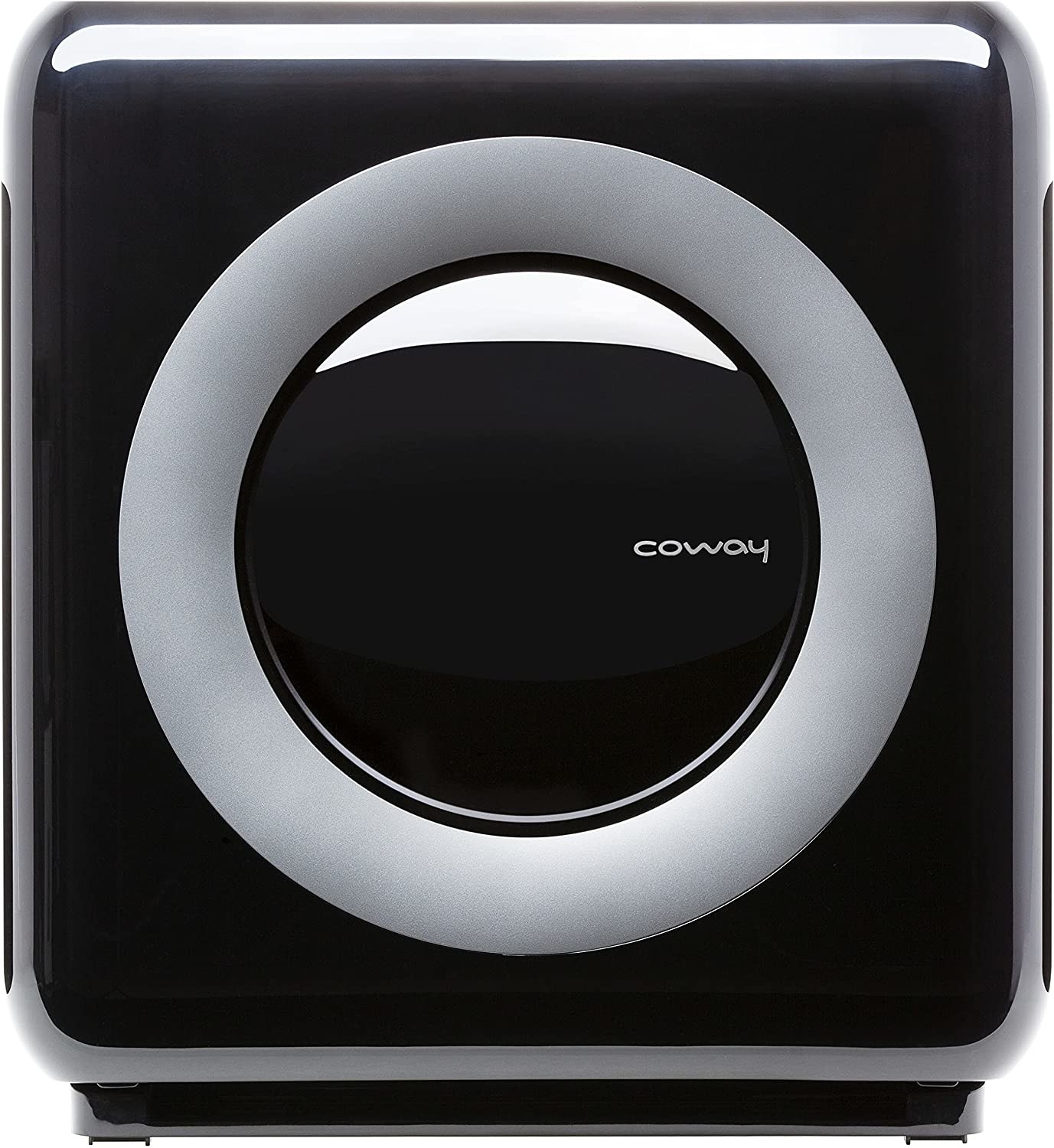
If you’re looking for maximum features in an effective air purifier without getting into crazy cost territory, this may be the one. The four-stage filtration system includes a pre-filter, deodorization filter, HEPA filter, and an ionizer in a combination technology to help capture and reduce up to 99.97% of particles from the air. The pre-filter is permanent and washable, and there’s an indicator that tells you when you need to change your HEPA filter to keep the unit functioning properly. In addition, there are LED lights that use a pollution sensor to communicate how clean or dirty your indoor air is in real time. There are three manual fan speeds plus an auto mode that optimizes fan speed based on air quality, and an eco-mode that engages automatically when no pollution has been detected for 30 minutes. It accommodates rooms up to 361 square feet with CADR ratings as follows: dust 246, pollen 240, and smoke 233.
Promising review: “After the fires last year we decided to buy this highly rated product for our bedroom. It is a solid product, very silent and it saved us when there was a lot of smoke in the air (even with closed windows). We are so happy with it, we run it 24/7 and forget it is even there. Very low maintenance, easy to use, provides peace of mind regarding air quality.” —denvergal
What else to consider: This air purifier is not tiny by any means, but the square shape keeps it lower to the ground and less visually jarring among other furniture, in my opinion. I happen to prefer this sort of wider retro-style box design to the taller tower models, but that’s just me. Reviewers also note that it’s fairly loud on the maximum fan speed.
Best for: rooms of average size that would benefit from a low-profile, high-functioning smart air purifier that alerts users when it’s time for upkeep.
You can buy the Coway Airmega AP-1512HH from Amazon for around $193.

This Honeywell air purifier is actually more compact than many others on the list in terms of both its width and height. Granted it’s meant for rooms up to 190 square feet, which is smaller than the previous products we’ve mentioned. It’s AHAM verified to circulate and filter air in rooms of that size almost five times per hour. The filtration system functions similarly with an activated carbon pre-filter and HEPA filter to remove 99.97% of microscopic airborne particles. Honeywell now also offers enhanced filtration for odor and volatile organic compounds, which are chemicals that are released from paints, cleaners, floor finishes, cosmetics, and more. It’s Energy Star certified with timers for two, four, or eight hours, after which it will turn off automatically, and a dimmer option for the control panel lights in case those bother you at bedtime.
Promising review: “I am very satisfied with my Honeywell HEPA air purifier. It cleans the air as indicated. I have two cats in the home, and this purifier does the job. I usually keep it in the living room, which is a rather large area room (living room and dining room combined). The cool air is also a plus. It's quiet when in a low setting. However, the sound from the high setting does not bother me. Highly recommended product!!” —Jackie, via Best Buy
What else to consider: Reviewers for other products on this list often called out that the Honeywell options tend to be louder, though reviews of this model say that it’s much quieter than previous Honeywell air purifiers. There are initial filters included, but both types are single use and need to be replaced regularly. While there’s no app control or air quality indicator light, there is a filter indicator light to know when it’s time to replace it.
Best for: average-sized rooms that need no more than a basic air purifier to get the job done without too many bells and whistles.
You can buy the Honeywell InSight HEPA Air Purifier from Best Buy for around $160.

As the name implies, this air purifier from Whirlpool is supposed to be one of the quietest options you can find. With a HEPA filter and activated carbon filter with antibacterial technology, the company promises that this device will eliminate over 99% of particles and bacteria that may grow on the filters at no more than a calm, white noise volume on any setting. There are three fan speeds, a timer, and sleep mode. This particular model is the medium size and is all around smaller than most of the other air purifiers on this list, though it’s only suitable for rooms up to 104 square feet for CADR ratings of 67 for smoke, 86 for dust, and 86 for pollen. The larger size is a bit taller and more expensive with higher CADR numbers to handle a larger space.
Promising review: “Wonderful product. Clears air well even on lowest setting, which you barely hear, btw. I REALLY like this air cleaner (as if you couldn't tell), and it takes up very little room. I DO recommend this product.” —Peggy L. Robertson
What else to consider: Again, the filters for this air purifier need to be completely replaced to keep it functioning properly long term, which is an added cost you should be aware of before buying. Reviewers agreed that the low setting was virtually silent, but noted that the high setting does produce white noise that’s not too loud.
Best for: smaller rooms like a bedroom or office that require a low-profile air purifier that won’t make much noise.
You can buy the Whirlpool Whispure WPT60B from Amazon for around $99.
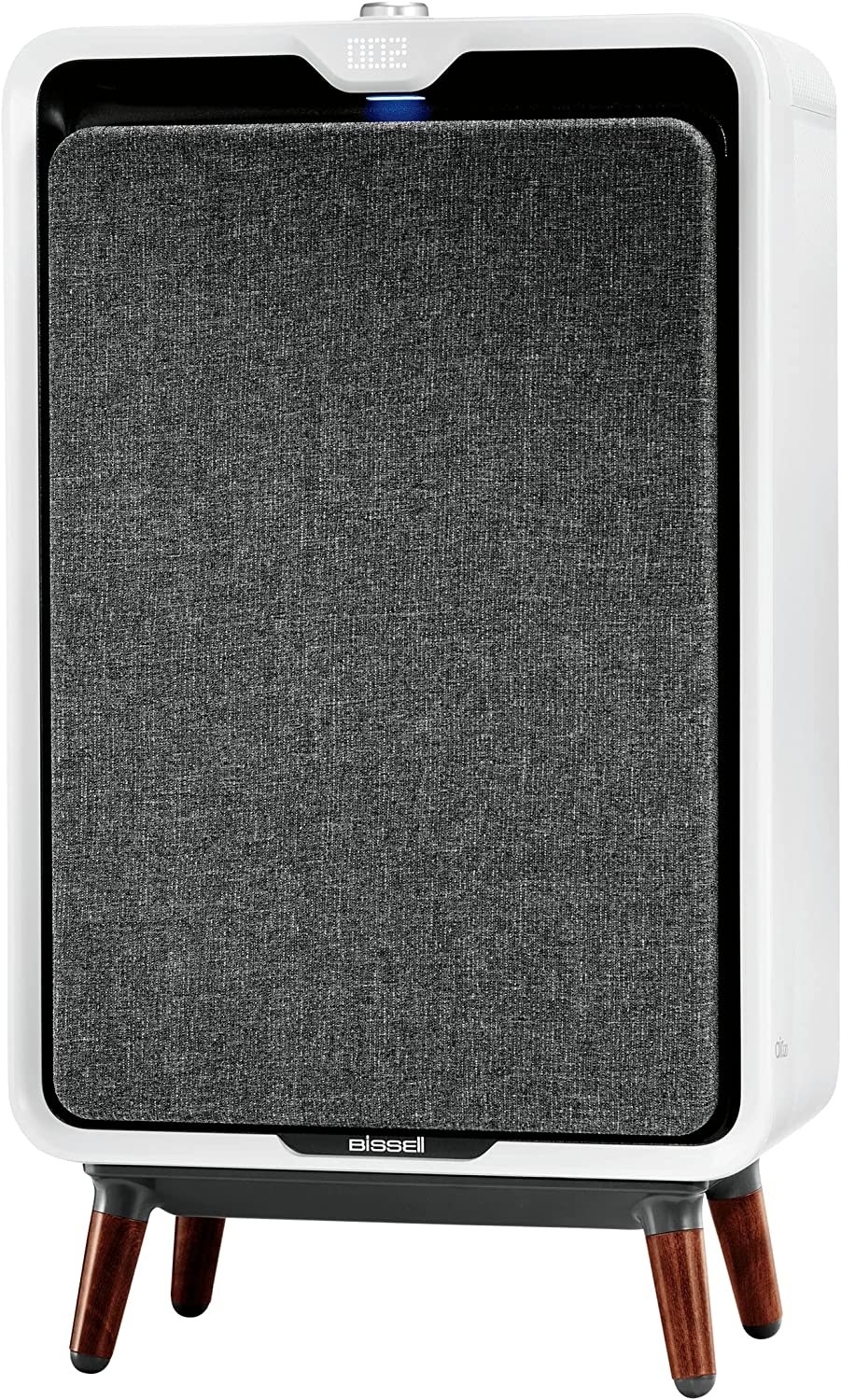
To me, this Bissell air purifier looks like a large standing speaker, but I kind of like that as far as aesthetics go. If it’s going to be out in the open and apparent, it might as well make a stylish statement. This AHAM verified smart air cleaner is on the pricier side but has the features and functionality to warrant that. Not only is there a washable fabric pre-filter, medical-grade HEPA filter, and honeycomb-structure activated carbon filter, but it also has a brushless digital motor and powerful XL fan with five speeds to pull the air through the filters and release clean air out of the top vent. It’s capable of one air change per hour in a 1,500-square-foot room and about five per hour in a 327-square-foot room. The particle sensors monitor air quality to provide color-coded readings and adjust the fan to the appropriate speed. At the lowest fan setting it claims to be barely audible, and it’s Energy Star rated for maximum energy efficiency. An indicator light will tell you when it’s time to change your filters, and the design does actually make it easier than others to swap those out.
Promising review: “This unit exceeds all expectations! We moved into our new home (built in the 1960s) a year ago and no candle or endless diffuser sticks could get rid of a subtle musty smell and likely the previous owner’s pet. In just a few days after plugging in this new air purifier – the smell is gone! I am sensitive to dust and mold and my allergy symptoms have improved too. Last but not least, this unit looks great in every room – we chose to place it in our family room near our kitchen where we spend most of our time. It arrived in great condition and set up was easy!” —Mary Carol
What else to consider: Bissell recommends changing the filter every six months as opposed to 12, which could definitely add up over time. The CADRs (211 CFM for smoke, 245 for pollen, and 221 for dust) are verified for a 327-square-foot room.
Best for: medium to large rooms that could use a statement piece with premium air-purifying capability.
You can buy the Bissell air320 Smart Air Purifier from Amazon for around $270.
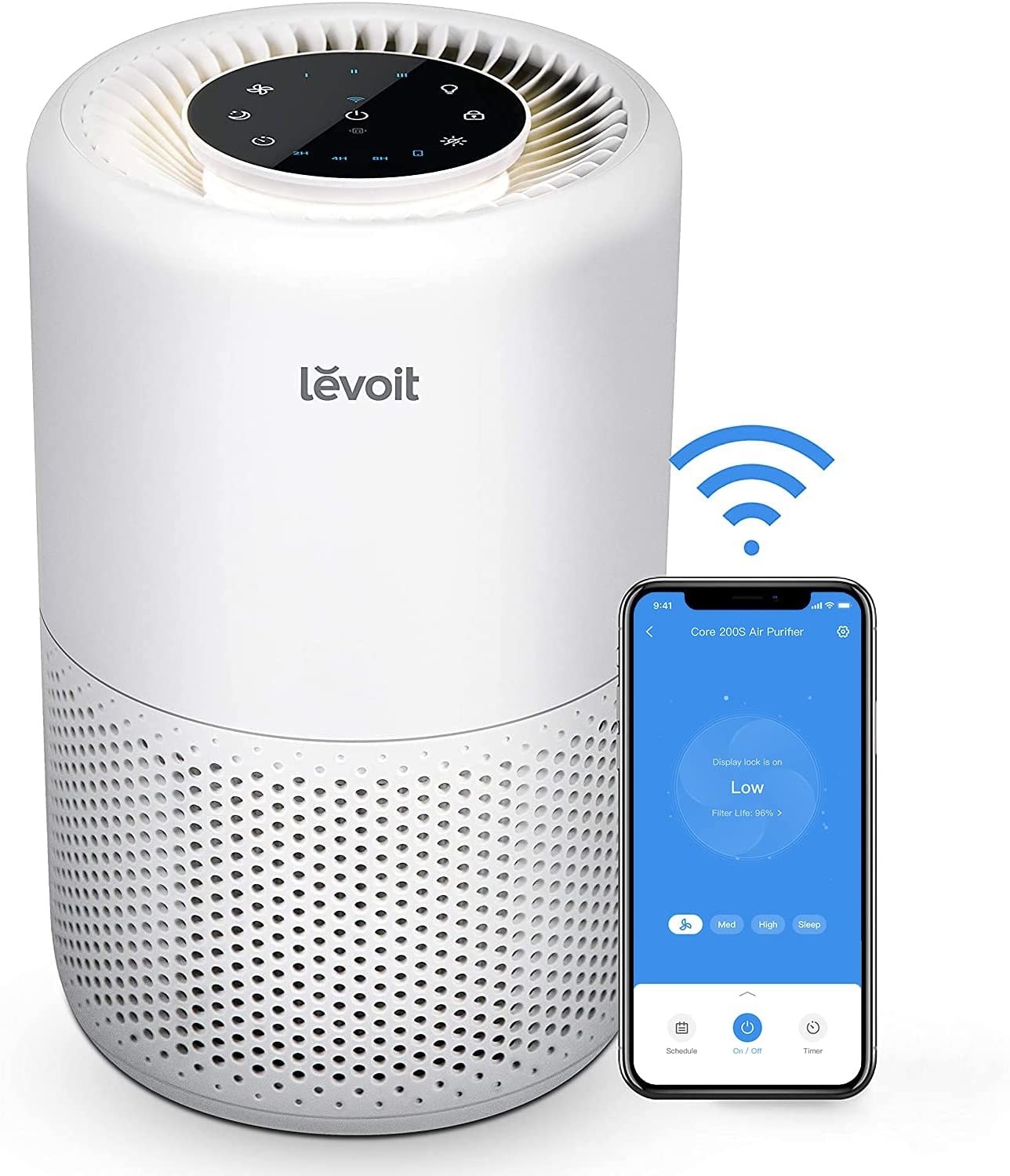
If you like your home appliances to have app controls and Alexa compatibility, this Levoit air purifier could be your winner. It’s more of a tabletop size, the smallest so far on this list, yet still promises to refresh the air five times per hour in rooms up to 187 square feet. You can monitor the life of the H13 True HEPA filter, set timers, and create a purification schedule all using the app or by commanding Alexa or Google Assistant with your voice (though it can also be controlled via the touchscreen on top). It also includes an activated carbon filter to help capture those larger particles before filtering out the smaller ones. This model also claims to operate quietly enough that it won’t disturb your sleep, meetings, or conversations no matter the fan speed.
Promising review: “I love this air purifier. I have owned one for a bit and decided I needed a second for another room. The quality is incredible. Pros: easy to clean, easy to use, adaptable for various times of the day (night mode, 3 levels, new filter light, etc.), inexpensive for the quality. As someone who has had asthma since 6 months of age, I highly recommend it!!” —Fort Worth Cathy
What else to consider: This is a great, compact air purifier, and though Levoit says that the fan uses special technology to purify faster and increase indoor circulation, it simply can’t be as large as the fans in some of the bigger devices that can suck in more air, faster. The size and low volume do, however, make it a better option to keep close by.
Best for: targeted placement on a desk or bedside table in a smaller room to concentrate purification exactly where you need it.
You can buy the Levoit H13 Air Purifier from Amazon for around $90.

This list wouldn’t be complete without a Dyson option, because as expensive as they are, we can’t deny that they’re well designed and effective. They make a whole line of bladeless, multifunctional air purifier/heater/fans that have become instantly recognizable. This model has a HEPA filter in the base to capture particles from the air sucked in by the fan, which can run at 10 different speeds. It’s AHAM certified with an overall CADR of 90 in a recommended room size of 400 square feet. It comes with a filter, but there’s also a filter indicator light to tell you when it needs changing. On top of all of that generally standard functionality, it also offers temperature control with a thermostat to produce heat in the winter and cool air with a fan in the summer. The Dyson Link app allows you to control every function of the fan and shows you air quality reports that the device automatically monitors. It also promises to operate quietly and the LED light display dims when it’s in sleep mode, which can be set for up to nine hours.
Promising review: “Very quiet. Helped clean air from pet dander and there was a noticeable difference. With winter, it heats perfectly and the remote is a nice touch.”—GXM74, via Best Buy
What else to consider: Since this air purifier also does several other things, it may not be the absolute best when it comes to purification specifically. The powerful fan does, however, mean that it’s circulating the purified air better than most. It’s also by far the most expensive product we recommend, so it’ll likely be a splurge item.
Best for: larger rooms that need some purification, increased circulation, and temperature control all from one sleek unit.
You can buy the Dyson Pure Hot Cool Link HP02 Air Purifier from Amazon for around $428.
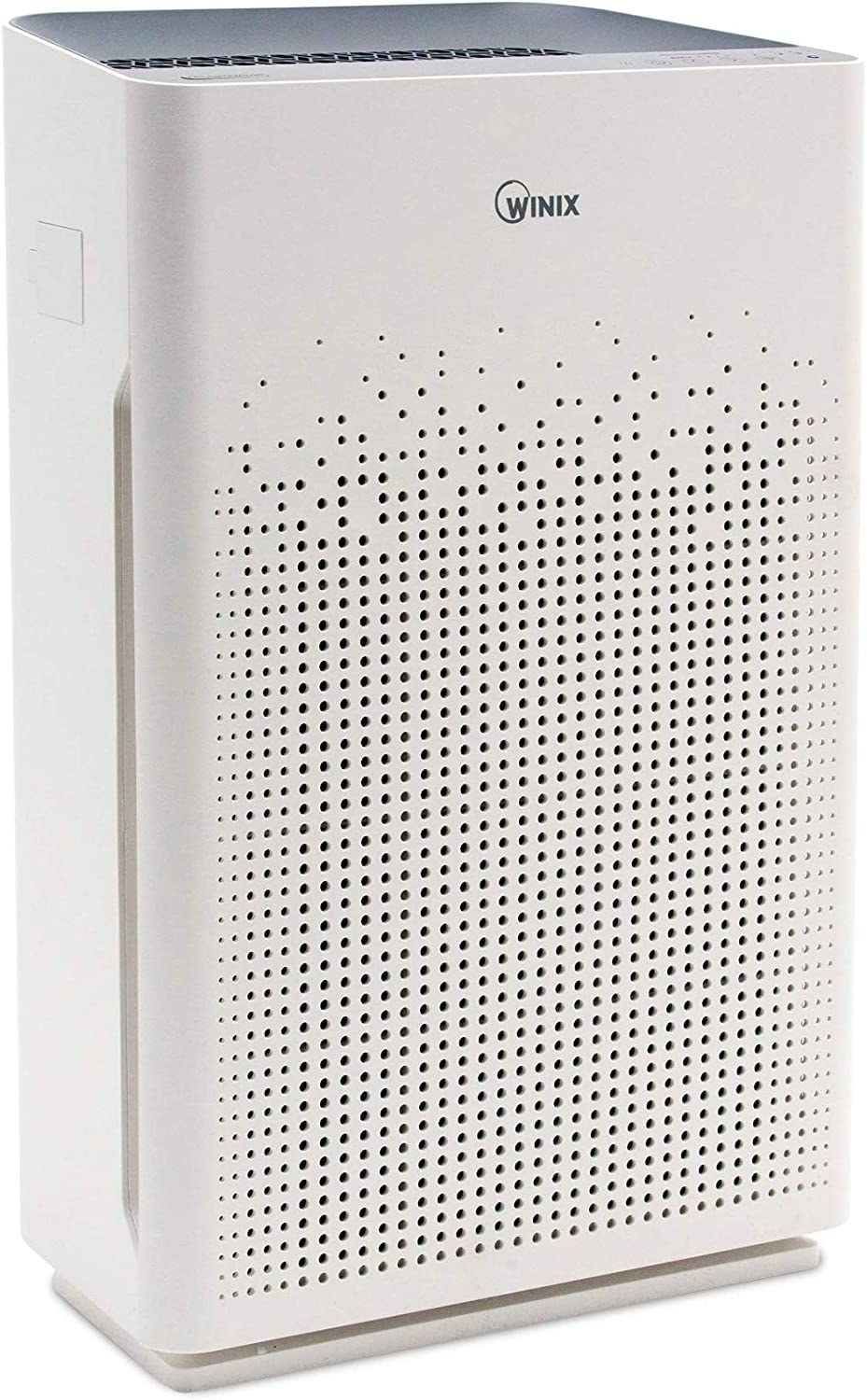
This Winix model designed to purify rooms up to 360 square feet has everything you could need in an air purifier — a true HEPA filter, plasma wave technology, AHAM verification, CADR ratings of 233, 240, and 230 for dust, pollen, and smoke respectively. Plus, it’s Wi-Fi enabled with app controls and Alexa compatibility if you prefer voice commands.
Promising review: “I keep one in the living room and the other in my bedroom. You can tell the difference in the air quality starting day one. And when you clean the filters you’ll see just how much dust it catches. Highly recommend for families. The auto level functions kick in whenever I am cooking and the auto night function works great.” —Eric Polanco
What else to consider: It’s not the most subtle or design-y air purifier, but it has great functionality at a price point that’s more manageable than those in the Dyson tier. The main complaints from reviewers were issues with the noise it makes and the app control.
Best for: a high-tech air purifier that you won’t mind taking up space.
You can buy the Winix 1022-0214-00 Wi-Fi Air Purifier from Amazon for around $223.
